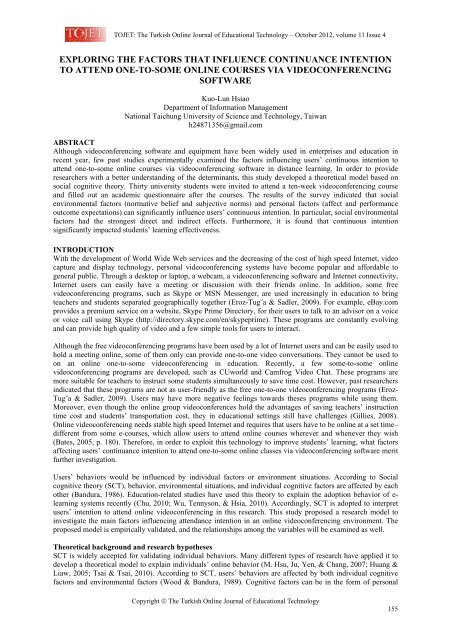october 2012 - TOJET the Turkish online journal of educational ...
october 2012 - TOJET the Turkish online journal of educational ...
october 2012 - TOJET the Turkish online journal of educational ...
You also want an ePaper? Increase the reach of your titles
YUMPU automatically turns print PDFs into web optimized ePapers that Google loves.
<strong>TOJET</strong>: The <strong>Turkish</strong> Online Journal <strong>of</strong> Educational Technology – October <strong>2012</strong>, volume 11 Issue 4<br />
EXPLORING THE FACTORS THAT INFLUENCE CONTINUANCE INTENTION<br />
TO ATTEND ONE-TO-SOME ONLINE COURSES VIA VIDEOCONFERENCING<br />
SOFTWARE<br />
Kuo-Lun Hsiao<br />
Department <strong>of</strong> Information Management<br />
National Taichung University <strong>of</strong> Science and Technology, Taiwan<br />
h24871356@gmail.com<br />
ABSTRACT<br />
Although videoconferencing s<strong>of</strong>tware and equipment have been widely used in enterprises and education in<br />
recent year, few past studies experimentally examined <strong>the</strong> factors influencing users’ continuous intention to<br />
attend one-to-some <strong>online</strong> courses via videoconferencing s<strong>of</strong>tware in distance learning. In order to provide<br />
researchers with a better understanding <strong>of</strong> <strong>the</strong> determinants, this study developed a <strong>the</strong>oretical model based on<br />
social cognitive <strong>the</strong>ory. Thirty university students were invited to attend a ten-week videoconferencing course<br />
and filled out an academic questionnaire after <strong>the</strong> courses. The results <strong>of</strong> <strong>the</strong> survey indicated that social<br />
environmental factors (normative belief and subjective norms) and personal factors (affect and performance<br />
outcome expectations) can significantly influence users’ continuous intention. In particular, social environmental<br />
factors had <strong>the</strong> strongest direct and indirect effects. Fur<strong>the</strong>rmore, it is found that continuous intention<br />
significantly impacted students’ learning effectiveness.<br />
INTRODUCTION<br />
With <strong>the</strong> development <strong>of</strong> World Wide Web services and <strong>the</strong> decreasing <strong>of</strong> <strong>the</strong> cost <strong>of</strong> high speed Internet, video<br />
capture and display technology, personal videoconferencing systems have become popular and affordable to<br />
general public. Through a desktop or laptop, a webcam, a videoconferencing s<strong>of</strong>tware and Internet connectivity,<br />
Internet users can easily have a meeting or discussion with <strong>the</strong>ir friends <strong>online</strong>. In addition, some free<br />
videoconferencing programs, such as Skype or MSN Messenger, are used increasingly in education to bring<br />
teachers and students separated geographically toge<strong>the</strong>r (Eroz-Tug˘a & Sadler, 2009). For example, eBay.com<br />
provides a premium service on a website, Skype Prime Directory, for <strong>the</strong>ir users to talk to an advisor on a voice<br />
or voice call using Skype (http://directory.skype.com/en/skypeprime). These programs are constantly evolving<br />
and can provide high quality <strong>of</strong> video and a few simple tools for users to interact.<br />
Although <strong>the</strong> free videoconferencing programs have been used by a lot <strong>of</strong> Internet users and can be easily used to<br />
hold a meeting <strong>online</strong>, some <strong>of</strong> <strong>the</strong>m only can provide one-to-one video conversations. They cannot be used to<br />
on an <strong>online</strong> one-to-some videoconferencing in education. Recently, a few some-to-some <strong>online</strong><br />
videoconferencing programs are developed, such as CUworld and Camfrog Video Chat. These programs are<br />
more suitable for teachers to instruct some students simultaneously to save time cost. However, past researchers<br />
indicated that <strong>the</strong>se programs are not as user-friendly as <strong>the</strong> free one-to-one videoconferencing programs (Eroz-<br />
Tug˘a & Sadler, 2009). Users may have more negative feelings towards <strong>the</strong>ses programs while using <strong>the</strong>m.<br />
Moreover, even though <strong>the</strong> <strong>online</strong> group videoconferences hold <strong>the</strong> advantages <strong>of</strong> saving teachers’ instruction<br />
time cost and students’ transportation cost, <strong>the</strong>y in <strong>educational</strong> settings still have challenges (Gillies, 2008).<br />
Online videoconferencing needs stable high speed Internet and requires that users have to be <strong>online</strong> at a set time–<br />
different from some e-courses, which allow users to attend <strong>online</strong> courses wherever and whenever <strong>the</strong>y wish<br />
(Bates, 2005, p. 180). Therefore, in order to exploit this technology to improve students’ learning, what factors<br />
affecting users’ continuance intention to attend one-to-some <strong>online</strong> classes via videoconferencing s<strong>of</strong>tware merit<br />
fur<strong>the</strong>r investigation.<br />
Users’ behaviors would be influenced by individual factors or environment situations. According to Social<br />
cognitive <strong>the</strong>ory (SCT), behavior, environmental situations, and individual cognitive factors are affected by each<br />
o<strong>the</strong>r (Bandura, 1986). Education-related studies have used this <strong>the</strong>ory to explain <strong>the</strong> adoption behavior <strong>of</strong> elearning<br />
systems recently (Chu, 2010; Wu, Tennyson, & Hsia, 2010). Accordingly, SCT is adopted to interpret<br />
users’ intention to attend <strong>online</strong> videoconferencing in this research. This study proposed a research model to<br />
investigate <strong>the</strong> main factors influencing attendance intention in an <strong>online</strong> videoconferencing environment. The<br />
proposed model is empirically validated, and <strong>the</strong> relationships among <strong>the</strong> variables will be examined as well.<br />
Theoretical background and research hypo<strong>the</strong>ses<br />
SCT is widely accepted for validating individual behaviors. Many different types <strong>of</strong> research have applied it to<br />
develop a <strong>the</strong>oretical model to explain individuals’ <strong>online</strong> behavior (M. Hsu, Ju, Yen, & Chang, 2007; Huang &<br />
Liaw, 2005; Tsai & Tsai, 2010). According to SCT, users’ behaviors are affected by both individual cognitive<br />
factors and environmental factors (Wood & Bandura, 1989). Cognitive factors can be in <strong>the</strong> form <strong>of</strong> personal<br />
Copyright © The <strong>Turkish</strong> Online Journal <strong>of</strong> Educational Technology<br />
155
















